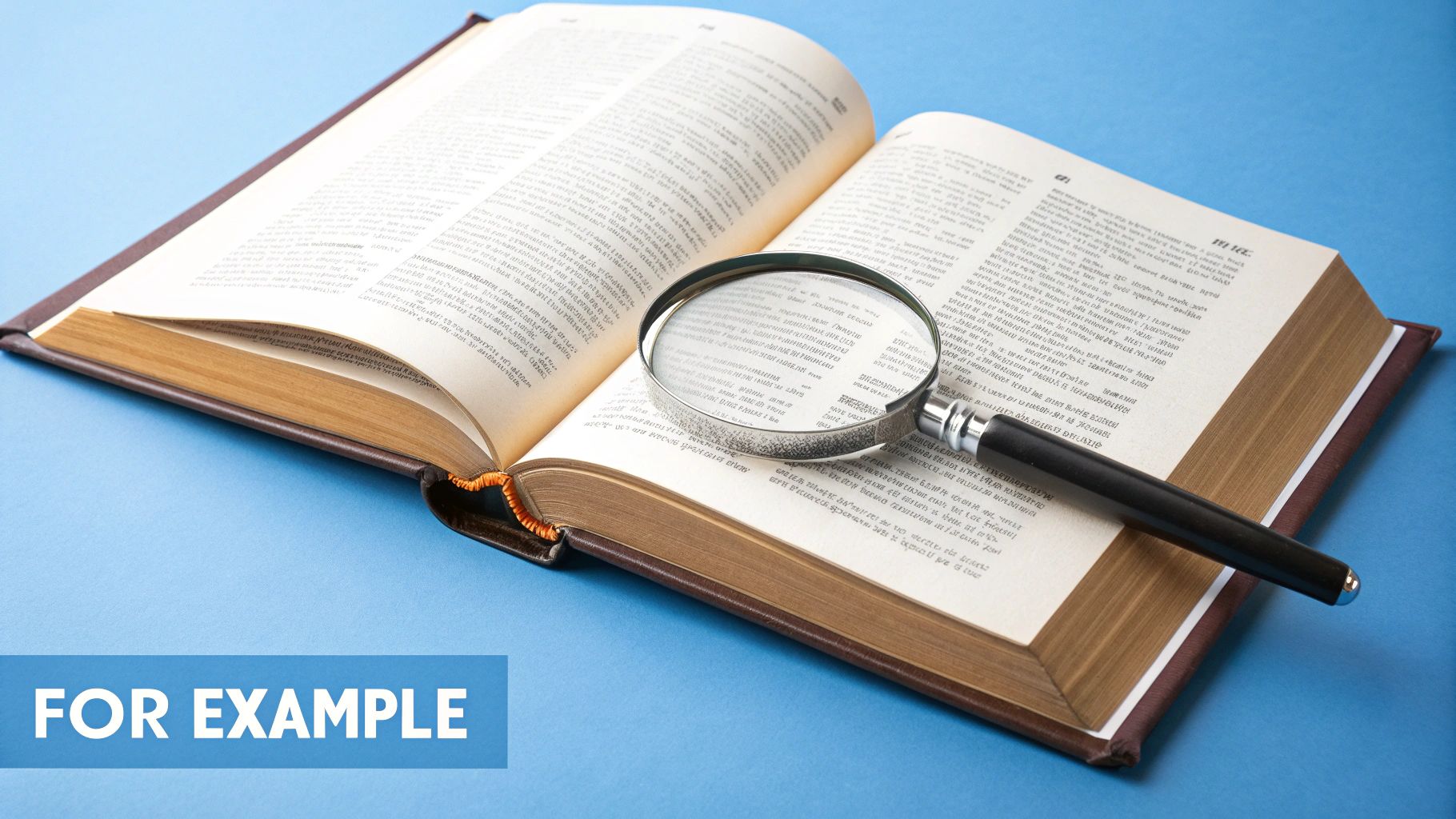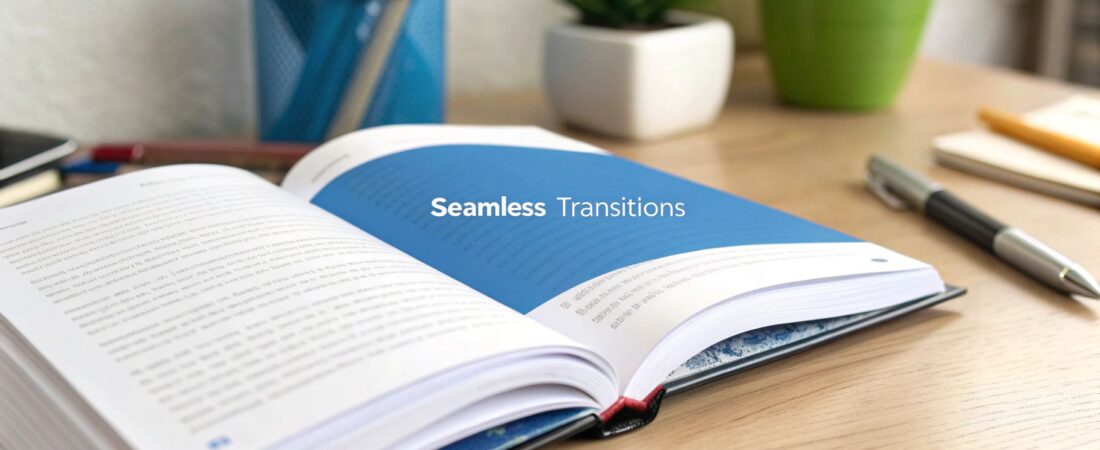Writing with Flow: The Power of Smooth Transitions
This listicle provides paragraph transition examples to elevate your writing. Strong transitions create cohesive, engaging content by connecting ideas effectively. Learn six essential transition types—chronological, contrasting, additive, causal, illustrative, and conclusive—with clear examples. Mastering these techniques will significantly improve your essays, research papers, and any written work. Smooth transitions guide your reader seamlessly through your arguments, creating a more persuasive and enjoyable reading experience.
1. Chronological Transitions
Chronological transitions are essential tools for guiding readers through a sequence of events or ideas. They establish a clear timeline, showing how one action, step, or idea follows another in time. This type of transition is like creating a roadmap for your reader, making it easy for them to follow the progression of your narrative or argument. This is particularly important in paragraph transition examples, as it helps maintain a coherent and logical flow between sentences and paragraphs. These transitions are invaluable for storytelling, historical accounts, process descriptions, scientific papers detailing experimental processes, and procedural explanations, ensuring readers understand the order and relationship between different stages. By creating temporal relationships between ideas, chronological transitions prevent confusion and establish a natural structure that mimics how many events unfold in real life.

For example, imagine you're explaining the process of writing a research paper. You might use chronological transitions like "First," "Second," and "Finally" to outline the steps involved: choosing a topic, conducting research, writing a draft, revising, and submitting. This clear chronological order helps readers grasp the process easily. Similarly, historical writers, like David McCullough, masterfully employ these transitions to create captivating narratives, weaving together events in a compelling and understandable sequence. Another strong example can be seen in scientific papers and procedural documentation, where demonstrating a step-by-step process is crucial for replication and comprehension.
Here are some more examples demonstrating the effective use of chronological transitions within paragraph transition examples:
- Initially, the experiment showed promising results. Subsequently, we observed unexpected side effects. Eventually, we determined the optimal approach.
- Before the economic crisis, spending was at an all-time high. During the recession, consumers drastically changed their habits. After the recovery began, a new pattern of cautious optimism emerged.
While chronological transitions offer significant advantages, they also have potential drawbacks. Overuse can lead to predictable and monotonous writing. They might also oversimplify complex relationships between ideas, especially when cause-and-effect isn't strictly linear. For instance, while they work well for instructions and processes, they might not be suitable for comparative analyses or arguments requiring a more nuanced approach.
Tips for Effective Use:
- Vary your vocabulary: Avoid repeating the same transition words. Use synonyms like "afterward," "meanwhile," "prior to," and "following" to keep your writing engaging.
- Use specific time markers: Instead of vague terms like "later," use precise time references like "In 2020" or "On July 15th" to enhance clarity and context.
- Relevance is key: Ensure the chronological order genuinely contributes to your argument or explanation. Don't force chronology where it isn't necessary.
- Combine with other transitions: Integrate chronological transitions with other types, like causal or contrastive transitions, to create more sophisticated and dynamic writing.
Chronological transitions deserve a prominent place in any discussion of paragraph transition examples because they provide a fundamental framework for organizing information and guiding readers through a logical progression. By understanding their strengths and weaknesses, and by employing the tips provided, you can effectively use these transitions to enhance the clarity and impact of your writing.
2. Contrasting Transitions
Contrasting transitions are essential tools for creating dynamic and engaging writing, especially in academic papers, persuasive essays, and argumentative pieces. They signal a shift in perspective, introducing an opposing viewpoint, contradictory evidence, or an alternative interpretation. This shift creates intellectual tension and encourages deeper critical thinking by presenting a more nuanced and balanced analysis. By acknowledging and addressing opposing arguments, writers demonstrate a thorough understanding of the topic and build a stronger case for their own position. This technique is particularly valuable for paragraph transition examples, allowing you to seamlessly guide your reader through complex ideas and differing perspectives.

Contrasting transitions act as signposts, alerting the reader to the upcoming change in direction. This prepares them for information that challenges or differs from what was previously presented. This element of surprise can make your writing more engaging, keeping readers actively involved in processing the information. For college students and high school seniors working on research papers and persuasive essays, mastering contrasting transitions is crucial for presenting a well-rounded and sophisticated argument.
Features and Benefits:
- Signals opposition or contradiction: Clearly marks a shift to an opposing viewpoint.
- Creates balanced analysis: Presents multiple perspectives, demonstrating a comprehensive understanding of the topic.
- Enhances critical thinking: Encourages exploration of alternatives and deeper analysis.
- Builds sophistication in argumentative writing: Elevates the level of discourse and demonstrates intellectual rigor.
Pros:
- Strengthens arguments: Addressing counterpoints preemptively bolsters your own position.
- Creates nuance and depth: Shows an understanding of the complexities of the issue.
- Demonstrates fair consideration of opposing views: Builds credibility and trust with the reader.
- Helps anticipate and address reader objections: Proactively addresses potential criticisms.
Cons:
- Potential for confusion: Overuse can create a back-and-forth rhythm that disorients the reader.
- May weaken persuasion: If contrasts aren't resolved effectively, it can undermine your argument.
- Risk of appearing contradictory: Requires careful handling to avoid seeming indecisive or uncertain.
Examples of Contrasting Transitions in Paragraph Transition Examples:
- "Many economists argue for increased regulation; however, critics point to potential unintended consequences."
- "The traditional approach emphasizes individual responsibility. In contrast, modern perspectives often consider systemic factors."
- "Despite strong sales figures, the company faces significant challenges in maintaining market share."
Tips for Effective Use:
- Explain the significance: Don't just present contrasting ideas; explain why the contrast matters. What are the implications of these differing viewpoints?
- Strategic word choice: Use stronger contrast words like "however," "nevertheless," "on the other hand," or "conversely" for major points of disagreement. Less emphatic words like "but" or "while" can be used for smaller shifts.
- Logical flow: Ensure the contrasting point logically follows from the previous discussion. The transition should feel natural and not abrupt.
- Resolution (when appropriate): In some cases, you'll need to resolve the presented contrast, showing how your argument ultimately prevails despite the opposing viewpoint.
Popularized By:
The use of contrasting transitions is widespread in academic writing, particularly in the humanities and social sciences. Opinion columnists, such as Thomas Friedman and Maureen Dowd, also frequently employ this technique to create engaging and thought-provoking pieces. Legal writing, especially in court opinions and briefs, relies heavily on contrasting transitions to present different legal interpretations and arguments. By understanding and implementing these techniques, young writers can significantly improve the clarity, depth, and persuasive power of their work.
3. Additive Transitions
Additive transitions are your go-to tools for building upon an idea. They introduce supplementary information, extra examples, supporting evidence, or further explanations that bolster your initial point. Think of them as the building blocks of a strong argument or a comprehensive explanation. These transitions signal to the reader that you're providing complementary material to strengthen, clarify, or extend the original point. This makes them essential in various types of writing, from explanatory essays and research papers to detailed analyses and even persuasive speeches. They create a sense of accumulation, showing the reader that your argument is well-supported and your understanding of the topic is thorough.

Additive transitions work by creating clear connections between related ideas. They guide the reader through your line of reasoning, showing how each new piece of information contributes to the overall picture. For example, you might introduce a statistic to support a claim, followed by a real-world example that illustrates the statistic's relevance. By using additive transitions like "furthermore," "moreover," or "in addition," you explicitly signal the relationship between these pieces of information, making your writing more cohesive and persuasive. These transitions are crucial for providing comprehensive coverage of a topic and maintaining forward momentum in your writing, creating rich, detailed explanations that resonate with your audience. They help you create a cumulative case, strengthening your arguments with accumulated evidence.
Here are a few examples of additive transitions in action, demonstrating effective paragraph transition examples:
- "The policy has economic benefits. Furthermore, it addresses long-standing social inequities." Here, "furthermore" introduces an additional benefit of the policy, strengthening the overall argument for its implementation.
- "The study demonstrated a correlation between diet and heart health. Additionally, it revealed unexpected benefits for cognitive function." "Additionally" introduces a further positive outcome of the study, adding to its significance.
- "Renewable energy sources reduce carbon emissions. Moreover, they create new job opportunities in emerging sectors." "Moreover" presents another compelling reason to support renewable energy, broadening the scope of the argument.
While additive transitions are powerful tools, overuse can lead to overly lengthy prose that obscures your main points. Too many additions can create a listing effect that feels mechanical and disengages the reader. The key is to ensure each addition genuinely enhances your point rather than just adding bulk.
Tips for Effective Use:
- Relevance: Ensure each addition genuinely strengthens your point, providing relevant and valuable information.
- Variety: Vary your additive transitions (e.g., "furthermore," "additionally," "also," "moreover," "in addition") to avoid repetition and maintain reader interest.
- Hierarchy: Use stronger additive transitions for more significant additions, creating a clear hierarchy of information. For instance, "moreover" often signals a more impactful addition than "also."
- Conciseness: Be mindful of length. Avoid adding unnecessary details that might dilute your core message.
Additive transitions deserve their place in any writer's toolkit because they provide a structured way to develop and support ideas. They are particularly valuable for college students, high school seniors, and young adults aged 18-25 who are navigating complex academic and professional writing tasks. Learn more about Additive Transitions. By mastering these transitions, you can elevate your writing, creating clear, compelling, and comprehensive arguments that leave a lasting impact.
4. Causal Transitions
Causal transitions are essential tools for creating clear and logical connections between ideas in your writing. They establish cause-and-effect relationships, demonstrating how one action, event, or condition leads to another. This makes them invaluable for various types of writing, from explanatory essays and scientific reports to historical analyses and persuasive arguments. By using causal transitions effectively, you can guide your readers through a chain of reasoning, helping them understand the "why" behind the "what." These transitions play a critical role in building a compelling narrative and strengthening your overall argument.

Causal transitions work by explicitly linking two or more ideas, highlighting the causal relationship between them. They signal to the reader that one concept is a direct or indirect result of another. This clear articulation of cause and effect enhances the flow and coherence of your writing, making it easier for readers to follow your train of thought. For instance, instead of simply stating two related facts, you can use a causal transition to connect them logically. Instead of saying "The team practiced hard. They won the championship," you could say, "The team practiced hard; consequently, they won the championship." This small change significantly strengthens the connection between the two ideas.
Here are some examples of causal transitions in action, showcasing their versatility in different contexts:
- Scientific Explanation: "Increased greenhouse gas emissions trap heat in the atmosphere. Therefore, global temperatures are rising."
- Economic Analysis: "Demand for the product surged. As a result, prices increased significantly."
- Historical Analysis: "The assassination of Archduke Franz Ferdinand sparked a chain of events. Ultimately, this led to the outbreak of World War I."
- Argumentative Essay: "The current education system disadvantages students from low-income families. Consequently, we need to implement reforms that promote equal opportunities."
Tips for Using Causal Transitions Effectively:
- Verify True Causation: Ensure a genuine cause-and-effect relationship exists before using a causal transition. Don't mistake correlation for causation. Just because two things happen together doesn't mean one causes the other.
- Choose Appropriate Transition Words: Select words that accurately reflect the strength of the causal relationship. "Partly because" indicates a weaker connection than "primarily because."
- Build Causal Chains Carefully: When constructing complex arguments, use causal chains strategically to show how multiple factors contribute to an outcome.
- Acknowledge Multiple Causes: Recognize that many situations have multiple contributing factors. Avoid oversimplification by acknowledging other potential causes when appropriate.
Pros of Using Causal Transitions:
- Clear Logical Connections: They create easily understandable links between ideas, improving clarity and coherence.
- Stronger Arguments: In persuasive writing, causal transitions demonstrate the consequences of actions or policies, making arguments more convincing.
- Explanation of Complex Processes: They effectively explain complex processes, historical developments, or scientific phenomena.
- Analytical Thinking: They promote analytical thinking and problem-solving by encouraging a deeper understanding of cause and effect.
Cons of Using Causal Transitions:
- Oversimplification: If used carelessly, they can oversimplify complex relationships.
- False Causation: They can imply causation where only correlation exists, leading to inaccurate conclusions.
- Logical Fallacies: If causation isn't properly established, they can lead to logical fallacies that weaken your argument.
Causal transitions deserve a prominent place on this list of paragraph transition examples because they are fundamental to building well-structured and logically sound arguments. They are essential for any writer aiming to explain, persuade, or analyze effectively. By understanding how to use them correctly, you can elevate your writing and communicate your ideas with greater clarity and impact, making them especially useful for college students and young adults tackling complex academic assignments and developing their critical thinking skills.
5. Illustrative Transitions
Illustrative transitions are key tools for clarifying abstract ideas and supporting arguments by connecting them to concrete examples. They bridge the gap between theory and practice, making complex concepts more accessible and memorable. This makes them an essential type of paragraph transition example, especially for academic writing, persuasive essays, explanatory articles, and instructional materials. Essentially, illustrative transitions answer the question, "Can you give me an example?" within the flow of your writing.
These transitions work by providing specific instances, case studies, anecdotes, or real-world scenarios that directly relate to the preceding general statement or abstract concept. This grounds the concept in tangible evidence, making it easier for readers to grasp and remember. Instead of simply stating a general principle, you provide concrete evidence to showcase it in action.
Features of Illustrative Transitions:
- Connects abstract concepts to concrete examples: They provide a tangible representation of an idea.
- Makes complex ideas more accessible: Simplifies understanding by showing, not just telling.
- Provides evidence for generalizations: Backs up claims with specific instances, strengthening your argument.
- Creates memorable anchors for key points: Examples make concepts stick in the reader's mind.
Pros:
- Increases reader comprehension of difficult concepts: Provides clarity and context.
- Makes writing more engaging and relatable: Real-world examples create connection and interest.
- Strengthens persuasive appeals through concrete evidence: Supports claims and enhances credibility.
- Helps readers visualize abstract ideas: Transforms intangible concepts into understandable scenarios.
Cons:
- Examples may oversimplify complex concepts if not chosen carefully: A poor example can misrepresent the idea.
- Can distract from main points if examples are too elaborate: Overly long examples can derail the flow of your writing.
- May not be persuasive if examples aren't representative: Atypical examples weaken the argument.
Examples of Illustrative Transitions in Action:
- Technology: Advanced machine learning algorithms can detect subtle patterns in data. For instance, Google's DeepMind system identified eye diseases from retinal scans with 94% accuracy.
- Social Issues: Economic inequality manifests in various social outcomes. To illustrate, children from low-income neighborhoods have 30% less access to green spaces than those from affluent areas.
- Leadership: Effective leadership requires emotional intelligence. Consider how Jacinda Ardern's empathetic response to the Christchurch shooting demonstrated compassionate governance.
Tips for Effective Use:
- Choose examples that directly support your specific point: Relevance is key.
- Ensure examples are relevant to your audience's experience or knowledge: Consider your readers' background.
- Explain the significance of the example if it isn't immediately obvious: Don't assume the connection is clear.
- Use a mix of hypothetical and real-world examples for different effects: Vary your approach for maximum impact.
When and Why to Use Illustrative Transitions:
Use illustrative transitions whenever you introduce a complex or abstract concept. They are particularly helpful in academic writing, persuasive essays, presentations, and any type of explanatory content. For college students and high school seniors working on research papers, illustrative transitions are invaluable for providing evidence and making arguments more compelling.
Learn more about Illustrative Transitions
Illustrative transitions deserve a prominent place on this list of paragraph transition examples because they are fundamental to effective communication. They enhance clarity, boost engagement, and strengthen arguments, making them a must-have tool for any writer aiming to connect with their audience and convey complex information effectively. By providing concrete examples, you offer readers a clear and memorable path to understanding.
6. Conclusive Transitions: Sealing the Deal with Your Writing
Conclusive transitions are essential tools for effective writing, especially for paragraph transition examples. They signal the end of a discussion or argument, summarizing key points and driving home your final message. Think of them as the closing arguments in a courtroom or the final chords of a symphony—they provide a sense of completion and leave a lasting impression on your audience. These transitions are crucial for any structured communication requiring a strong finish, from essays and research papers to persuasive speeches and presentations. They help your readers understand that you're wrapping up your argument and presenting your final thoughts.
Conclusive transitions work by explicitly signaling closure. They prepare the reader for a summary of the main points and the ultimate takeaway from the preceding discussion. By using phrases like "In conclusion," "Therefore," or "Ultimately," you guide your audience towards the logical endpoint of your argument. This clear signaling enhances comprehension and retention of your core message.
Here's how conclusive transitions function within a piece of writing:
- Summarization: They condense the key arguments and evidence presented earlier, reinforcing their significance.
- Reinforcement: They restate the central thesis or main idea in light of the evidence presented, creating a sense of cohesion.
- Resolution: They provide closure, preventing the writing from feeling abrupt or unfinished. This is particularly important for academic writing, where a strong conclusion is often as important as a strong introduction.
Examples of Successful Implementation:
- In conclusion, the evidence strongly supports implementing the proposed policy changes, leading to improved public health outcomes.
- Therefore, we can determine that the hypothesis is partially supported, though further research is needed to explore the remaining discrepancies.
- Ultimately, the success of any organizational change depends on both leadership commitment and employee engagement, highlighting the need for a comprehensive approach.
Actionable Tips for Using Conclusive Transitions:
- Avoid introducing entirely new ideas: Your conclusion should synthesize existing points, not introduce new, undeveloped arguments.
- Echo key terminology from your introduction: This creates a sense of unity and reinforces your core message.
- Vary your vocabulary: Don't just rely on "In conclusion." Explore more sophisticated options like "In summary," "Thus," "Finally," or "As a result."
- Ensure logical flow: Your conclusion must be a logical consequence of the preceding discussion, not a disconnected afterthought.
Pros and Cons of Using Conclusive Transitions:
Pros:
- Provides closure and prevents abrupt endings.
- Helps readers retain the most important information.
- Strengthens the overall impact of the writing.
- Ties together multiple threads of an argument.
Cons:
- Can feel formulaic if not thoughtfully constructed.
- May inadvertently introduce new ideas that should have been developed earlier.
- Risk of oversimplifying complex discussions in summary.
Conclusive transitions deserve their place in this list of paragraph transition examples because they are essential for creating well-structured and impactful writing. They guide your readers to your ultimate takeaway and leave a lasting impression. For college students, high school seniors, and young adults navigating academic and professional writing, mastering conclusive transitions is key to crafting compelling and persuasive arguments. Learn more about Conclusive Transitions This is particularly helpful when aiming for a strong finish in academic papers, presentations, and even professional emails. Understanding how to effectively conclude an argument can significantly impact your communication skills and overall success in academic and professional settings. By utilizing these transitions effectively, writers aged 18-25 can improve the clarity and impact of their communication, setting them up for success in their academic and professional pursuits.
Paragraph Transition Types Comparison
| Transition Type | 🔄 Implementation Complexity | 📊 Expected Outcomes | ⚡ Resource Requirements | 💡 Ideal Use Cases | ⭐ Key Advantages |
|---|---|---|---|---|---|
| Chronological Transitions | Low – straightforward temporal order | Clear timeline, smooth narrative flow | Minimal – basic sequencing tools | Storytelling, historical accounts, processes | Creates clear timeline; prevents confusion |
| Contrasting Transitions | Medium – careful logical structuring | Nuanced arguments, balanced viewpoints | Moderate – research and analysis | Argumentative writing, academic papers | Strengthens arguments by addressing counterpoints |
| Additive Transitions | Low to Medium – adding successive info | Expanded coverage, cumulative evidence | Moderate – detailed content | Explanatory writing, research papers | Builds comprehensive, detailed explanations |
| Causal Transitions | Medium – verify cause-effect relations | Logical flow, persuasive reasoning | Moderate – cause-effect validation | Scientific discourse, historical analysis | Clarifies cause-effect; supports problem-solving |
| Illustrative Transitions | Low – introducing relevant examples | Increased comprehension, relatable writing | Low to Moderate – selecting examples | Academic writing, persuasive essays | Makes abstract ideas concrete and memorable |
| Conclusive Transitions | Low – summarizing and closing | Strong closure, reinforced key points | Low – summary skills | Essays, research papers, speeches | Provides closure; emphasizes main message |
From Choppy to Compelling: Mastering the Art of Transitions
From chronological transitions that guide your reader through time to conclusive transitions that tie everything together, this article has explored six key types of paragraph transitions—additive, contrasting, causal, illustrative, and conclusive—with numerous paragraph transition examples to illustrate their use. Mastering these different approaches is more than just a stylistic flourish; it's about creating clarity, building momentum, and ultimately, making your writing more persuasive and engaging. By understanding how to effectively link your ideas, you transform disjointed thoughts into a cohesive and compelling narrative. This is crucial for any type of writing, from essays and emails to presentations and, especially, academic work. If you're working on a research project, for example, strong transitions are essential for demonstrating a clear line of reasoning. For further guidance on crafting compelling and well-structured research papers, exploring dedicated resources like these research paper writing tips from PDF AI can be invaluable.
The ability to smoothly transition between paragraphs is a hallmark of strong writing. It signals a sophisticated understanding of structure and flow, allowing you to guide your audience effortlessly through your arguments and ideas. This skill is especially valuable for college students and high school seniors navigating the complexities of academic writing. By implementing these paragraph transition examples, you'll elevate your essays, research papers, and other assignments, leaving a lasting impression on your readers.
Ready to take your writing to the next level? SmartStudi can help you perfect your transitions and polish your prose with its AI-powered writing assistance. SmartStudi provides real-time feedback and suggestions on your writing, including how to use transitions more effectively, so you can create clear, compelling content every time.
